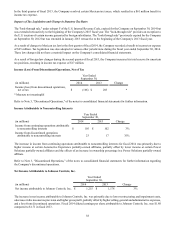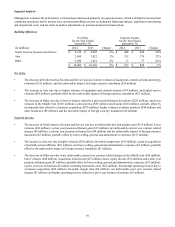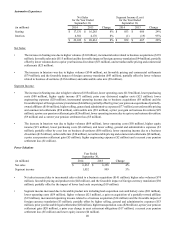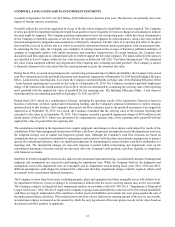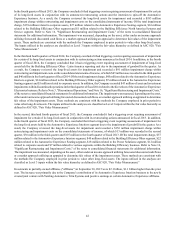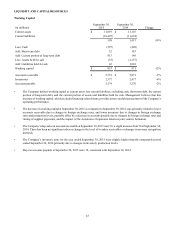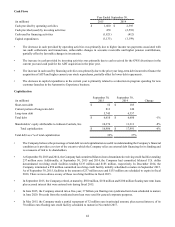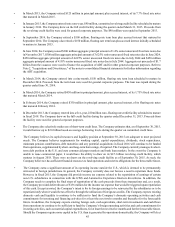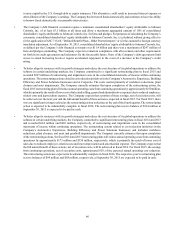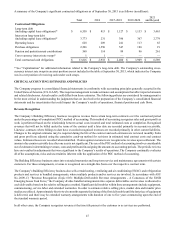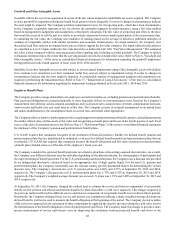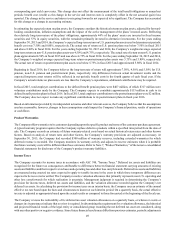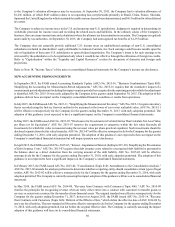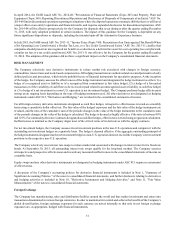Johnson Controls 2015 Annual Report Download - page 41
Download and view the complete annual report
Please find page 41 of the 2015 Johnson Controls annual report below. You can navigate through the pages in the report by either clicking on the pages listed below, or by using the keyword search tool below to find specific information within the annual report.41
GOODWILL, LONG-LIVED ASSETS AND OTHER INVESTMENTS
Goodwill at September 30, 2015 was $6.8 billion, $303 million lower than the prior year. The decrease was primarily due to the
impact of foreign currency translation.
Goodwill reflects the cost of an acquisition in excess of the fair values assigned to identifiable net assets acquired. The Company
reviews goodwill for impairment during the fourth fiscal quarter or more frequently if events or changes in circumstances indicate
the asset might be impaired. The Company performs impairment reviews for its reporting units, which have been determined to
be the Company’s reportable segments or one level below the reportable segments in certain instances, using a fair value method
based on management’s judgments and assumptions or third party valuations. The fair value of a reporting unit refers to the price
that would be received to sell the unit as a whole in an orderly transaction between market participants at the measurement date.
In estimating the fair value, the Company uses multiples of earnings based on the average of historical, published multiples of
earnings of comparable entities with similar operations and economic characteristics. In certain instances, the Company uses
discounted cash flow analyses or estimated sales price to further support the fair value estimates. The inputs utilized in the analyses
are classified as Level 3 inputs within the fair value hierarchy as defined in ASC 820, "Fair Value Measurement." The estimated
fair value is then compared with the carrying amount of the reporting unit, including recorded goodwill. The Company is subject
to financial statement risk to the extent that the carrying amount exceeds the estimated fair value.
During fiscal 2014, as a result of operating results, restructuring actions and expected future profitability, the Company's forecasted
cash flow estimates used in the goodwill assessment were negatively impacted as of September 30, 2014 for the Building Efficiency
Other - Latin America reporting unit. As a result, the Company concluded that the carrying value of the Building Efficiency Other
- Latin America reporting unit exceeded its fair value as of September 30, 2014. The Company recorded a goodwill impairment
charge of $47 million in the fourth quarter of fiscal 2014, which was determined by comparing the carrying value of the reporting
unit's goodwill with the implied fair value of goodwill for the reporting unit. The Building Efficiency Other - Latin America
reporting unit has no remaining goodwill at September 30, 2015 and 2014.
During fiscal 2013, based on a combination of factors, including the operating results of the Automotive Experience Interiors
business, restrictions on future capital and restructuring funding, and the Company's announced intention to explore strategic
options related to this business, the Company's forecasted cash flow estimates used in the goodwill assessment were negatively
impacted as of September 30, 2013. As a result, the Company concluded that the carrying value of the Interiors reporting unit
exceeded its fair value as of September 30, 2013. The Company recorded a goodwill impairment charge of $430 million in the
fourth quarter of fiscal 2013, which was determined by comparing the carrying value of the reporting unit's goodwill with the
implied fair value of goodwill for the reporting unit.
The assumptions included in the impairment tests require judgment, and changes to these inputs could impact the results of the
calculations. Other than management's projections of future cash flows, the primary assumptions used in the impairment tests were
the weighted-average cost of capital and long-term growth rates. Although the Company's cash flow forecasts are based on
assumptions that are considered reasonable by management and consistent with the plans and estimates management is using to
operate the underlying businesses, there are significant judgments in determining the expected future cash flows attributable to a
reporting unit. The impairment charges are non-cash expenses recorded within restructuring and impairment costs on the
consolidated statements of income and did not adversely affect the Company's debt position, cash flow, liquidity or compliance
with financial covenants.
Indefinite lived other intangible assets are also subject to at least annual impairment testing. A considerable amount of management
judgment and assumptions are required in performing the impairment tests. While the Company believes the judgments and
assumptions used in the impairment tests are reasonable and no impairment existed during fiscal years 2015, 2014 and 2013,
different assumptions could change the estimated fair values and, therefore, impairment charges could be required, which could
be material to the consolidated financial statements.
The Company reviews long-lived assets, including property, plant and equipment and other intangible assets with definite lives,
for impairment whenever events or changes in circumstances indicate that the asset’s carrying amount may not be recoverable.
The Company conducts its long-lived asset impairment analyses in accordance with ASC 360-10-15, "Impairment or Disposal of
Long-Lived Assets." ASC 360-10-15 requires the Company to group assets and liabilities at the lowest level for which identifiable
cash flows are largely independent of the cash flows of other assets and liabilities and evaluate the asset group against the sum of
the undiscounted future cash flows. If the undiscounted cash flows do not indicate the carrying amount of the asset is recoverable,
an impairment charge is measured as the amount by which the carrying amount of the asset group exceeds its fair value based on
discounted cash flow analysis or appraisals.









